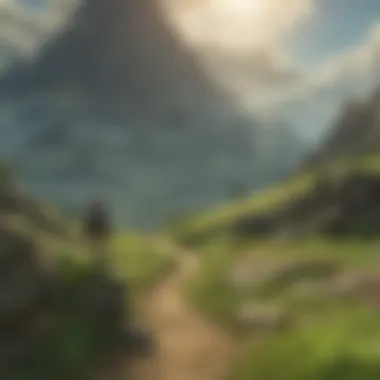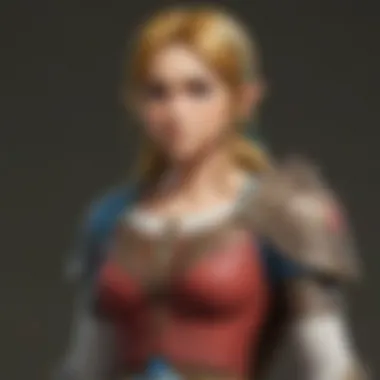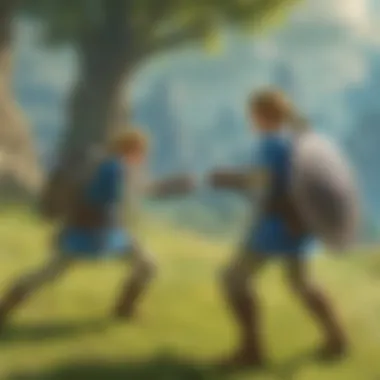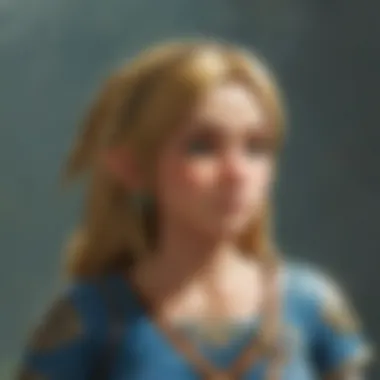Zelda: Breath of the Wild - A Comprehensive Analysis


Intro
Released on March 3, 2017, Zelda: Breath of the Wild quickly became a touchstone in modern gaming culture. This open-world game redefined the boundaries of exploration and adventure. Players find themselves in a vast Hyrule, where they can engage with the environment in ways both novel and intricate. The game promotes freeform exploration, enabling players to tackle challenges in countless manners. In this way, each player's journey becomes unique.
The game is layered with rich storytelling, complex characters, and detailed world-building. From the razed cliffs to the misty valleys, every corner of Hyrule serves as a canvas for discovery and challenge. Beyond its expansive open-world mechanics, the depth of the narrative propels players into its lore.
As one moves through this journey, various gameplay mechanics reveal themselves, including environmental interaction, item crafting, and intricate puzzle-solving. These aspects differentiate Breath of the Wild from its predecessors, welcoming both seasoned gamers and newcomers alike into its fold.
Understanding the implications of game's design choices aids the player in appreciating Hyrule beyond its surface. This analysis aims to provide critical insights that promote an in-depth understanding of what makes Zelda: Breath of the Wild feel revolutionary. Therefore, let us embark on a systematic exploration of reviews, character dynamics, lore, and strategies, enriching our experience with this landmark title.
"In Breath of the Wild, exploring takes priority over following a linear path, hence splitting the narrative into as many directions as players dare to go."
The subsequent sections will delve deeper into game reviews, character analyses, lore, and gameplay strategies. This approach promotes an engaging narrative while providing valuable insights into Zelda: Breath of the Wild.
Game Overview
The Game Overview section plays a crucial role in this article as it establishes a strong foundation for understanding Zelda: Breath of the Wild as a significant cultural and gaming landmark. By delving into both the release information and the development background, readers gain insight into how the game came to fruition and its initial reception. This context not only enriches the gameplay experience but also frames the discussion of the advanced gameplay mechanics and narrative themes that follow.
Release Information
Zelda: Breath of the Wild was released on March 3, 2017, simultaneously for the Nintendo Switch and Wii U. This dual launch was highly strategic, marking the debut of Nintendo's flagship console and ensuring a wide audience. The reaction at release was fervent, as fans eagerly anticipated a fresh approach to the beloved Zelda franchise. Players and critics alike noted the open world design and innovative gameplay, which distinguished it from its predecessors.
Breath of the Wild received multiple awards and accolades, establishing new benchmarks not only for the series but for the gaming industry entirely. Its reception included recognition such as the Game Awards best game of the year in 2017 and numerous nominations for various categories. The game swiftly climbed to critical acclaim, becoming a touchstone for future exploration in open-world gaming.
Development Background
The development of Breath of the Wild was an ambitious undertaking for Nintendo, led by producer Eiji Aonuma. The project was a significant departure from prior Zelda titles, characterized by an expansive open environment that encouraged player agency. Development began in earnest around 2011 after the launch of Skyward Sword. Inspired by the desire to create a new adventure within the familiar realm of Hyrule, the team invested significant time into designing a world where explorers would feel free to enjoy the vast landscapes without excessive confinement.
This shift from more linear game design to an open-world format required innovative programming and creative processes within Nintendo. Detailed attention was paid to landscape composition, NPC interactions, and dynamic weather patterns. Such features aimed to cultivate genuine immersion.
Reporting on the development drawn from team members' interviews revealed that a strong influence came from team explorations of vast terrains around the globe. This resulted in topographies that felt authentic and diverse.
“Our aim was not simply to create a world but to make Hyrule a vibrant existence builders could evaluate and explore as they played,” said Aonuma in one of the interviews about the development.
Through dedicated effort, they managed to create not just a game but a rich tapestry of interconnected systems. Thus, Zelda: Breath of the Wild marked itself as a revolutionary moment in gaming history, emblematic of the opportunities that open-world gameplay can provide.
Gameplay Experience
Importance of Gameplay Experience
The concept of Gameplay Experience is critical in understanding what makes Zelda: Breath of the Wild an iconic title. This section borrowed various elements from other games, making it a distinct experience while staying true to the series. The gameplay encourages player autonomy and exploration, offering numerous advantages, such as fostering creativity and personal discovery.
An effective Gameplay Experience has several benefits. It immerses players into the game's world, making them feel a genuine connection with Hyrule. Each action taken has consequences, including the ability to approach tasks in multiple ways. This openness serves as a significant consideration for players as they progress through the game. Enjoying various aspects of gameplay increases engagement and prolongs the overall experience, a cornerstone of this installment.
Open World Design
The Open World Design in Zelda: Breath of the Wild is revolutionary. Unlike previous entries in the franchise, which offered more linear pathways, this game provides players with a vast sandbox environment to explore. Players traverse different environments, from verdant fields to snowy mountains, each filled with secrets and surprises.
Point of interest in the open world is critical. The constant feeling of curiosity drives exploration. Landmarks guide the players while keeping the thrill of adventure intact. Within this expanse, the freedom to choose routes and approaches test can yield susprising outcomes that influence gameplay experience immensely. Players often recount their unique journeys, underscoring the importance of exploration.
Exploration and Adventure


Exploration in Breath of the Wild ties directly into the game's core themes. Many moments arise from spontaneity and curiosity. Making the experience rich, discovering hidden shrines or crafting materials ushers players toward rewarding encounters. This element paves the road for unthinkable adventures.
The vast terrain often encourages off-path journeys. Uncovering secrets turns into gameplay's heart. Each step or climb leads somewhere new, creating a sense of purpose. This dynamic prompts players to value curiosity as a pivotal aspect of their engagement with Zelda.
Combat Mechanics
The Combat Mechanics present in Zelda: Breath of the Wild offer a balance between challenge and fun. Combat encourages players to think strategically, integrating diverse strategies specific to various enemy types. The game oustands through its fluid actions, allowing smooth transitions between attacking, dodging, and defending, providing an exhilarating combat experience.
Furthermore, combat mechanics emphasize timing and finesse. Players must plan ahead and frequently adapt as circumstances change, which heightens the interaction between exploration and battles. This demand for skill growth creates satisfying mastery as one progresses through encounters.
Weapons and Item Management
Weapons and item management in Breath of the Wild stands unique compared to previous titles. The usage of individual items sees effects on gameplay mechanics within the vast landscapes and diverse encounters. Weapons can degrade over time, meaning much thought must be put into choosing which weapon is most suitable at any given time.
Managing these assets requires careful consideration. Resources like food and elixirs augment abilities or restore health. Players learn to gather relentlessly while balancing quantity against quality in this challenging survival-oriented world. Hence, kept your gear-managed smartly emerges as a central theme throughout the journey.
Puzzle-solving Elements
Problem-solving and critical thinking form the backbone of numerous challenges within Zelda: Breath of the Wild. Players are often required to consider unique solutions influenced by the environment. This interplay evokes a constant process and experimentation, contributing significantly to the overall gameplay experience.
Incorporating puzzles within shrine mechanics exposes players to new dynamics, enhancing both learning and satisfaction levels. Players discover new abilities, navigate obstacles effectively, and strengthen their skills through puzzle-solving progression. Skills sharpen alongside theoretical thinking, making the challenges intricately woven into crafting the gameplay's enduring legacy.
Engagement in gameplay areas creates lasting impression, resonating and aspiring for repeat explorations.
Narrative Structure
The narrative structure is vital in shaping the experience of Zelda: Breath of the Wild. It not only serves as a framework for the plot but deeply informs character motivations and theme progression. The way the story unfolds in overlapping timelines enhances engagement. Players become eager to unearth Hyrule's secrets while advancing through the game's expansive world. In this structure, actions carry significant weight, illustrating consequences that ripple through the immersive environment.
Plot Summary
The plot of Breath of the Wild positions Link, the protagonist, awakening from a long slumber. He learns of the looming threat posed by Calamity Ganon, who desires to consume Hyrule. The journey centers around reactivating four Divine Beasts to weaken this menace and ultimately confront Ganon. Each twist and turn leads players through diverse terrains while unveiling varied narratives associated with each main character detailing their perspectives, struggles, and hopes.
Players encounter multiple side quests that overlay the central arc, asking them to interact with various notable individuals, thus enriching the narrative. The gradual revelation of Ganon’s history and influences injects depth into the journey. The fragmented piece-meal presentation creates a layer of suspense, making players actively seek lore while plotting their course.
Character Development
Character development can be observed in Link's transition from a silent protagonist to an evolved hero compelled by responsibility. Zelda, on the other hand, is crafted through layers of resilience and complex expectations.
Her struggles are revealed not just through direct interaction but also found in the game's cutscenes. Notably, the struggles she faces are indicative of higher stakes; here is a princess bearing the weight of her kingdom upon her shoulders and striving against humanity’s flaws.
Moreover, the Champions—Urbosa, Daruk, Mipha, and Revali—are illustrated in deftly produced side stories often activated through shrine quests. Their backstories augment the main narrative and provide valuable context, showing them as critical figures within Hyrule’s adventurous texture.
Themes and Motifs
Breath of the Wild touches upon various themes. One prevalent theme involves the notion of freedom. Players possess the liberty to traverse, explore, and tackle challenges attached to the unfolding story. There exists an emphasis on balance regarding nature rallies further indicative through interactions with wildlife and their environments.
Themes of courage and responsibility appear flecked through Link's impending desire to succeed while underscoring past losses that haunt Zelda’s resolve. Interactions between linking technology and magic preserve contrasting yet essential connections explored through physics, corrosion, and unconditional loyalty of certain non-playable characters.
As players immerse within each unique narrative and overlapping themes, they uncover a structured tapestry illustrating Hyrule’s inherent fragility yet undaunted potential. The oftcited virtues of perseverance and unity reveal layers compelling further exploration and understanding among readers and players alike.
“The experience of Breath of the Wild is ultimately shaped not only by what happens within the game but by the stories players will take away from it.”


Characters of Hyrule
The characters in Zelda: Breath of the Wild serve as integral pieces of the narrative and gameplay. They enrich the player experience by providing deep context, emotional engagement, and continuity within the storied franchise. Unlike past titles, this installment emphasizes the importance of characters beyond their roles, presenting them almost as companions in a vast, wandering journey. Their stories are not just accessories to the gaming experience; they vividly illustrate the breath of life within Hyrule. Through character development, players deeply connect with the unfolding drama against the backdrop of a catastrophic world.
Link: The Hero
Link stands as the primary protagonist and his character arc signifies more than just the hero's journey. Awakening from a long slumber without memories, players experience the world through his eyes. From the beginning, Link grapples with his former identity and obligation to rescue Princess Zelda and defeat Calamity Ganon. Yet the game balances this quest with numerous side activities and life-impacting decisions made by Link.
Link’s arsenal represents the qualities he embodies. The variety of weapons and items encourage players to adopt tactics that suit their play style. Whether players prefer stealth, brute strength, or magical solutions, Link’s consistent adaptability is foundational. His character also symbolizes courage, tradition, and the inevitable clash between growth and stagnation. This transforms players' engagements from simple run-of-the-mill confrontations into significant acts of defiance against despair and destruction.
Zelda: The Princess
Princess Zelda emerges throughout as more than just a damsel in distress. Her essense is subtly woven into the game mechanics and overall lore. The dialogue and environmental storytelling reveal her commitment to her role as the bearer of the Triforce of Wisdom. Yet, her struggle is tangible—her confinement within Hyrule Castle during the upheaval speaks to her challenges more than her moments of splendor
The complex layers of her personality and inevitable duty form the core of Hyrule's redemption narrative. Zelda's connection to the power of the Triforce ultimately becomes a point of poignant strength amidst overwhelming despair. For players, realizing that she is not merely waiting but actively working against Ganon changes the dynamic. This gives depth as Link's journey is illuminized by Zelda's influence and struggles.
The Champion’s Legacy
The narrative is enriched by the inclusion of the Champions—a group of remarkable heroes tasked with assisting Link and forming the backbone of resistance against Ganon. Each champion, represented by the divine beasts, reflects a unique aspect of Hyrule’s culture, showcasing diverse strategies and strengths.
Unraveling the lore of each champion provides players with a deeper appreciation for their sacrifices. Each story switches perspective on evolving values, exploring the implications of courage, friendship, and responsibility. The Graav Brothers, Daruk, Mipha and others, layer the game's narrative with complexity while prompting players to acknowledge that the calamity affects everyone—giving this tale an overwhelming sense of collective strife and potential healing.
The Zelda series often illustrates character stories as pivotal, shaping every experience encountered in the realm. Their essence molds the player’s journey deeply.
Cultural Impact
The cultural impact of Zelda: Breath of the Wild extends far beyond gameplay mechanics and visual innovations. It has reshaped the landscape of open-world gaming and inspired countless discussions about narrative complexity and game design. Players around the globe regard it not just as a game, but as a piece of art that resonates on multiple levels.
Critical Reception
Upon release, Breath of the Wild received critical acclaim from various publications. Reviewers praised its intricate world-building and the remarkable freedom it affords players. Specifically, major platforms like IGN and GameSpot lauded its non-linear gameplay and rich environment, which encourages exploration and curiosity. The game earned numerous awards, including Game of the Year, further establishing its legacy. These accolades contributed to its overall reputation within the gaming community, making it a significant point of reference for both new and returning gamers. A positive review often highlighted the pioneering mechanics that recalibrated player expectations, setting a high bar for future titles.
Completing the Modern Zelda Experience
Breath of the Wild serves as a pivotal chapter in the Zelda franchise, integrating both nostalgia and innovation. The design philosophy revolves around player agency, allowing individuals to approach challenges in various ways. Traditional elements from earlier games, like heart containers and dungeon mechanics, mesh seamlessly with modern gameplay; this evolutionary leap supports the transition between past and present in the franchise. Engaging with the vast, open world not only hones skills but also deepens appreciation for Zelda’s lore. In this way, it acts as both a standalone experience and a tribute to its predecessors, making it essential for any fan's journey.
Fan Community and Activism
The game's influence extends beyond the playerbase into a vibrant fan community. Online forums, especially platforms like Reddit, serve as hubs for sharing strategies, artwork, and modding resources. Active participation in discussions has brought life to theories surrounding plot intricacies and characters' fates. Players also engage in activism through community events, advocating for accessibility features in future games. This sense of community reinforces belonging and shared excitement, helping fans feel invested in the Zelda universe. Furthermore, often they will not only react to content released by Breath of the Wild but also generate their own narratives, expanding the lore and exploring alternate interpretations of beloved characters and settings.
Technical Innovations
The role of technical innovations in Zelda: Breath of the Wild goes beyond mere aesthetics and performance; it establishes a foundation for other gameplay mechanics that enhances the players' experience. Nintendo's commitment to technical advancement allows for a more dynamic and engaging world. This opens channels for exploration and expression, enriching the overall gameplay narrative. These technological aspects integrate seamlessly with the core features of the game, ensuring that both casual and seasoned gamers are similarly engaged.
Graphics and Art Direction
The graphics in Breath of the Wild are characterized by a distinct art style that balances realism with a painted look. The influence of the cel-shaded technique adds charm, yet it does not sacrifice detail. Vivid colors and dynamic lighting work in tandem to create a captivating atmosphere. The portrayal of Hyrule, from the lush landscapes of the forests to the stark desolation of the deserts, reflects the game’s approach towards storytelling.
The visual design decisions made were significant for both player immersion and narrative communication.
- Environment Deployment: Different regions offer unique visual spectacles, encouraging the player to explore further.
- Dynamic Weather System: Weather effects affect gameplay. Rain may turn surfaces slippery while sunny days reveal hidden items. This enhances the immersion Factor.


Combination of artistic elements creates a beautifully cohesive world that invites players to lose themselves within its boundaries.
"The art direction manages to elevate nostalgia while propelling challengers into an unparalleled adventure."
Sound Design and Music
Sound design in Breath of the Wild integrates music and ambient sounds to form holistic audio experiences that significantly enhance gameplay. Music score is often atmospheric, adjusting to in-game contexts. This flow of audio further immerses the player.
In contrast to redundant motifs of earlier Zelda games, Breath of the Wild applies more subtle melodies.
- Environmental Sounds: Animals, wind, and rustling leaves contribute textures to the immersive landscape.
- Musical Variants: Each region has unique tunes tailored to its essence, which helps accentuate the game world diversity.
This subtle approach cultivates emotional connections and deepens player engagement, allowing for narrative immersion amidst expansive exploration.
Engine and Performance
The engine employed for Zelda: Breath of the Wild represented an evolution in capabilities for Nintendo. This advancement ensured multiple layers of interactions within the expansive world of Hyrule.
Optimizations made helped with:
- Frame Rate Consistency: The engine maintained a stable performance, even during intense gameplay moments.
- Environmental Interactions: Players can manipulate surroundings in various ways, adding depth to gameplay and discovery.
Such innovations provide a framework where creative problem solving becomes more than a task; it becomes adventure itself.
Challenges and Critiques
Understanding the challenges and critiques surrounding Zelda: Breath of the Wild provides crucial insight into its design choices and implications for game development. The discusion helps identify areas of improvement while also acknowledging the boundaries of innovation within the gaming landscape.
Controversial Design Choices
Zelda: Breath of the Wild derived both praise and criticism for its innovative design choices. Some players find the lack of traditional dungeons disheartening. Dungeons have long been a hallmark of Zelda games, providing structured challenges and thematic elements. This shift to an open-world environment has raised debates about whether players miss the narrative depth offered by dungeons. Another point of contention is the weapon durability system. Critics argue it disrupts immersion, as ruined weapons might block gameplay. Yet, supporters assert it encourages players to adopt new strategies daily, boosting exploration without reliance on familiar equipment.
This serves as a reflection of how game mechanics can diverge from established trends, leading to spirited conversation about how a franchise evolves. In Breath of the Wild, the mechanics that offer freedom can also frustrate players who favor clarity and predictability.
Balancing Exploration and Story
Finding a balance between exploration and storytelling poses a challenge. Breath of the Wild excels at providing an enormous world that encourages players to interact with their surrounds in organic ways. The narrative unfolds mostly through environmental hints and subtle interactions rather than traditional cutscenes. Some players thrive in this freedom, enjoying the discovery of lore piecemeal as they navigate Hyrule.
On the contrary, others feel detached from the core story and its characters. This design choice may marginalize critical plot sweeping for an expansive world. Critics argue it was easier to follow and engage with narratives in previous titles, complicating player investment in the story of Link and Zelda.
The End
The conclusion of our exploration into Zelda: Breath of the Wild is fundamental in synthesizing the game's major themes, technical achievements, and its impact on the gaming landscape.
Legacy of 'Breath of the Wild'
Zelda: Breath of the Wild is often highlighted as a turning point in game design. It established new benchmarks for open world experiences with its seamless gameplay and vast environmental storytelling. Considering its wide reception, the dedication from the developers shows in the game's attention to detail and player agency. THe integration of physics into gameplay mechanics allows for complex interaction between elements in the world, fostering creativity. Moreover, it prompted a reevaluation of player engagement in game worlds. Many developers chase the success of Breath of the Wild by incorporating similar free exploration mechanics, showcasing its influence on future projects. It not only secured its place within the Zelda franchise but also revolutionized family.)
Future of the Zelda Franchise
The future of the Zelda franchise seems bright, fueled by the trailblazing path carved by Breath of the Wild. Anticipation for the next installment remains high among fans, driven by the desire for further innovation. The evolution of gameplay mechanics noted in Breath of the Wild, such as environmental interactions and quest structuring are likely to inspire upcoming titles.
With considerations for story depth, character interaction, and aesthetic design, there seems to be a balance of maintaining tradition while embracing fresh concepts. Link and Zelda are well-poised for new journeys, as the dedicated community eagerly explores more of Hyrule's secrets. This invitation for intrigue ensures the franchise's longevity, promising that the exploration will never truly end.
As gamers move forward, the legacy and future of the Zelda series hinge upon a balance of innovation and homage to its rich history.
The enrichment for players from their personal adventures is invaluable, ensuring that every step taken within Hyrule carries meaning and depth. The anticipation for next chapter rises, as community involvement continues shaping its narrative trajectory.







